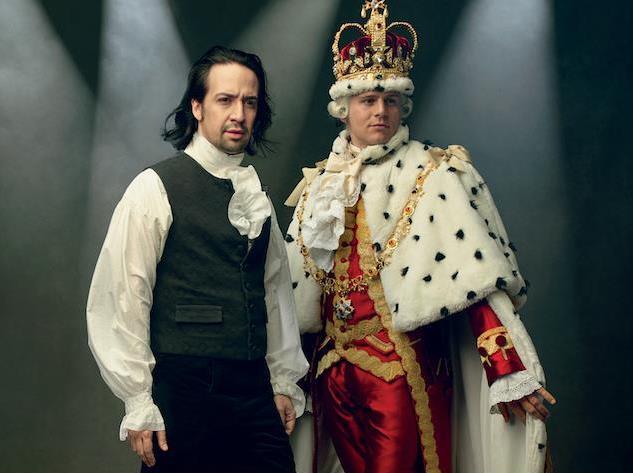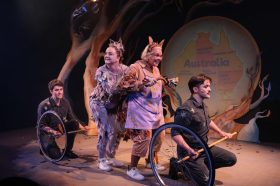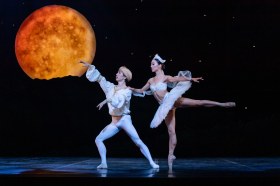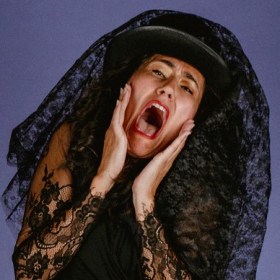What comes next? You’ve been freed. Do you know how hard it is to lead?
You’re on your own. Awesome. Wow. Do you have a clue what happens now?
“What Comes Next?” from Hamilton relays a “small query” from King George III after the Continental Army wins the American colonies’ independence: “What comes next?
Even though his question is now a few hundred years old, it’s become exceedingly more relevant in the past year—and not just because Hamilton is such a phenomenon. Many joked on social media that the Revolutionary War was the “original Brexit” after the shocking 2016 vote in the UK left Brits asking themselves this very question. And now it’s the question that millions of Americans are grappling with as we adjust to the reality that Donald Trump is our President. Americans now must not only ask what’s next on Trump’s agenda, but also what’s next in terms of preparing politically, economically, emotionally, and artistically for when his presidency actually begins. This is a crucial question, given the difficult emotional impact Trump’s election has had on so many people.
Today there is no clear answer to “what comes next?” but there is the possibility for what psychologists term post-traumatic growth, which we—as artists and as Americans—can strive for by understanding our relationship to our psychology and our art.
Collective trauma
Many Americans’ reactions to Trump’s victory—especially those whose identities are marginalized by Trump’s stances and promises during his campaign—actually mirror some of the post-traumatic stress symptoms experienced by a group after a collective trauma (a traumatic event experienced by a group, rather than individually). This is a phenomenon I researched in depth at Emerson College as a part of my Honours thesis as it related to terrorist-induced collective traumas—in particular the Boston Marathon bombing—and my research parallels the symptoms and reactions I’ve experienced lately, and observed in others.
According to sociologist Jeffrey Alexander in Cultural Trauma and Collective Identity, an event can be considered a collective trauma “when members of a collectivity feel they have been subjected to a horrendous event that leaves indelible marks upon their group consciousness, marking their memories forever and changing their future identity in fundamental and irrevocable ways.” This description sums up many conversations I’ve had with other members of groups marginalized by Trump’s policies—essentially anyone who is not a straight white man. In my research I defined this specific type of reaction as a subset of posttraumatic stress disorder (PTSD), which typically focuses on individual experiences, and termed it indirect traumatic response. The symptoms are almost identical to those of PTSD, which include flashbacks, hypervigilance, and dissociative symptoms (depersonalization/derealization).
For example, I noticed that for weeks after the election, seeing images of the White House—whether or not Trump was in them—would make me feel incredibly anxious and unsafe as I was triggered to think about how I felt on November 9 when Trump won. The exposure to images related to a collective trauma, especially repetitive images via the media was shown by several psychology studies to exacerbate or even cause posttraumatic stress symptoms. In the study “Exploring the Myths of Coping with a National Trauma: A Longitudinal Study of Responses to the September 11th Terrorist Attacks,” psychologists found that “many individuals who were not directly exposed to the attacks,” but were exposed through both live or recorded media, “reported symptoms both acutely and over the year afterwards at levels that were comparable to those individuals who experienced the attack proximally and directly.”
How theatre helps
The focus of my initial research was to examine the relationship between this media imagery—absorbed passively by audiences—and self-conscious “post-dramatic” theatre—absorbed actively by audiences—in the hopes of finding a light at the end of the tunnel for victims of collective trauma. My findings apply directly to the way that theatre artists and Americans who felt traumatized by the 2016 election results can not only heal and grow, but perhaps begin to reach out across the political aisle: post-traumatic growth.
Clinical psychologist Carol Tosone found post-traumatic growth in the aftermath of 9/11 by creating a guide to help other clinicians and therapists deal with their own reactions to collective trauma, while also continuing to be able to help their clients and patients. While her approach was through the community and language of psychology, I believe it can apply to theatre as well. This approach has the opportunity to be both healing for artists and audiences.
My research…gives me not only hope but empirical evidence that theatre has the potential to help members of the American community achieve posttraumatic growth and go on to defend the identities many felt attacked for in this election cycle.
I tested this approach in April 2016, the three-year anniversary of the Boston Marathon bombing, with a staged reading of my play Lockdown at Emerson College. The play takes place in Cambridge, Massachusetts on April 19, 2013, four days after the Boston Marathon Bombing, when the city of Boston and surrounding towns were put on lockdown in order to conduct a manhunt for Dzhokar Tsarnaev. The emotional, physiological, and psychological fallout of this event makes up the bulk of the play. The play’s conceit, thematically and structurally, is a dramatic representation of indirect traumatic response through a post-dramatic theatrical approach, using techniques such as repetition, fragmentation, dissociation, derealization, and surrealism to dramatize the experience of indirect traumatic response. Lockdown is not intended to be a form of therapy, but rather a tool for re-mediatization and conversation about the emotional experience of the Boston Marathon bombing and post-traumatic growth.
For the reading, I cast a group of Emerson student actors who were all part of the Boston community, some of whom had been present in Boston when the attacks happened and others who were elsewhere but now being a part of the Boston community were inextricably linked to the event’s effects. Rehearsals included in-depth discussions of what the event meant for all of us and how the actors responded to the material. After the reading, I held a talkback with the audience, all of whom members of the Boston community, which ended up lasting as long as the reading itself.
The talkback began with questions about the play but soon shifted to a sharing of memories and experiences related to the Boston Marathon bombing and 9/11. It was an inspiring and cathartic discussion for the audience, the cast, and myself. The open-ended nature of the play, which ended ambiguously, gave the audience an opportunity for a group sharing of memories in response to the overarching questions of “Where were you when the bombing happened?” and “What do you remember about it?” By employing an open-ended theatrical event, a shared experience with artists and audience was created. This allowed people on both sides of the fourth wall to eventually become comfortable sharing their experiences with each other, and supporting and validating each other’s complex and uncomfortable emotions around the event.
The power of connecting a community on an emotional level is one of the key foundations for reaching post-traumatic growth after a collective trauma. My research and this experience give me not only hope but empirical evidence that theatre has the potential to help members of the American community achieve post-traumatic growth and go on to defend the identities many felt attacked for in this election cycle.
Embracing our power
As theatre artists, our prerogative is not only to create and tell stories that evoke emotion in audiences, but also to start discussions and initiate change in the popular media. You don’t need to have the platform of the Hamilton actors, who were able to speak about their fears directly to Vice President-elect Mike Pence. You as a theatre artist have the power to help create post-traumatic growth in post-Trump America. You can keep asking questions with your art—of yourself, of your fellow theatre collaborators, and of audiences—about what’s happening right now. You can choose not to present passive messages to audiences who have not yet healed from this trauma. You can instead provide them with the ability to actively see and experience that what is happening now is not normal, and to not lose sight of that. You can use the platform of theatre to start discussions in a safe space. Remember that Americans who voted for Trump are a part of this community too, and the foundations of post-traumatic growth are listening to and emotionally supporting all members of the community. We need this now more than ever, and I can’t think of a better medium in which to do so, since theatre is so attuned to the intricacies of human emotions.
So perhaps you’re not ready to have the intersectionality conversation with your Trump-supporting uncle. But maybe (if you can get tickets) you can invite him to see Hamilton, a show that presents a different view of the country than the one he’s used to seeing in his neighborhood. Or maybe you can take him to the closest performance of the Every 28 Hours Plays , a national project highlighting civil rights in the US.
Or maybe you can create something yourself that will get your uncle and all audiences talking. Live theatre has always been a dialogue between artists and audiences. Let’s start having a dialogue about what matters to us in this traumatic time, and build a community of post-traumatic growth.
This article was first published in HowlRound.




